#Custom Metadata
Explore tagged Tumblr posts
Text
Build Your Custom Vocabulary with Org Dictionary
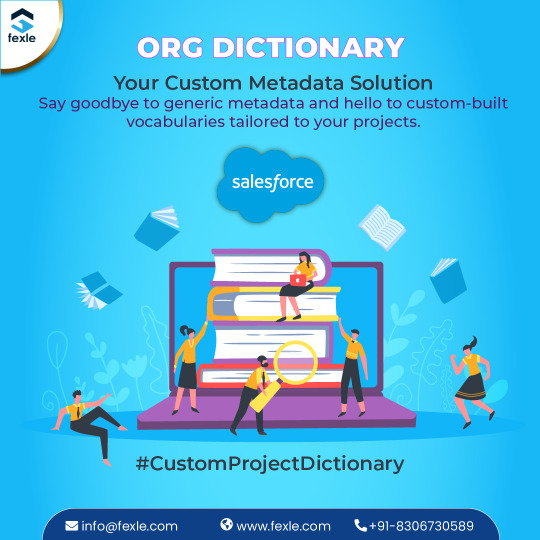
Picture this , A tool that lets you craft a unique vocabulary tailored just for your projects in Salesforce. With Org Dictionary, you can set up a personalized list of terms that make sense for your specific needs.
Whether you’re dealing with custom objects or unique fields, you can create and maintain a dictionary that grows with your project. It’s like having a custom glossary at your fingertips to ensure everyone on your team is on the same page.
Work together with your Salesforce consulting partner to maximize the benefits of Org Dictionary, ensuring your project is streamlined, organized, and effectively managed.
#Org Dictionary#fexle services#Custom Vocabulary#Salesforce Projects#Personalized Glossary#Custom Metadata#Tech Tools#Project Success
0 notes
Text
Manual data entry my beloathed
#the valley is posting#we do have a csv file but the cms doesn't support batch uploads and there's custom metadata and css stuff for each post anyways#so here's me manually entering over 300 posts sl;kjfal;f
2 notes
·
View notes
Text
This tool is optional. No one is required to use it, but it's here if you want to know which of your AO3 fics were scraped. Locked works were not 100% protected from this scrape. Currently, I don't know of any next steps you should be taking, so this is all informational.
Most people should use this link to check if they were included in the March 2025 AO3 scrape. This will show up to 2,000 scraped works for most usernames.
Or you can use this version, which is slower but does a better job if your username is a common word. This version also lets you look up works by work ID number, which is useful if you're looking for an orphaned or anonymous fic.
If you have more than 2,000 published works, first off, I am jealous of your motivation to write that much. But second, that won't display right on the public version of the tools. You can send me an ask (preferred) or DM (if you need to) to have me do a custom search for you if you have more than 2,000 total works under 1 username. If you send an ask off-anon asking me to search a name, I'll assume you want a private answer.
In case this post breaches containment: this is a tool that only has access to the work IDs, titles, author names, chapter counts, and hit counts of the scraped fics for this most recent scrape by nyuuzyou discovered in April 2025. There is no other work data in this tool. This never had the content of your works loaded to it, only info to help you check if your works were scraped. If you need additional metadata, I can search my offline copy for you if you share a work ID number and tell me what data you're looking for. I will never search the full work text for anyone, but I can check things like word counts and tags.
Please come yell if the tool stops working, and I'll fix as fast as I can. It's slow as hell, but it does load eventually. Give it up to 10 minutes, and if it seems down after that, please alert me via ask! Anons are on if you're shy. The link at the top is faster and handles most users well.
On mobile, enable screen rotation and turn your phone sideways. It's a litttttle easier to use like that. It works better if you can use desktop.
Some FAQs below the cut:
First off! If you're seeing an old version of this post, you may not have seen that we now have our first tool to poison AO3 fics! This is still experimental, and it's likely we'll find issues with it as people start using it! But if you want something like Glaze and Nightshade but for fic, this is what we have right now. Before you decide to use it, please read all the info you can--most importantly, using the poison in its current state makes your fic inaccessible to certain users. All the TTS tools I've tried work with this as long as your readers know to save the fic in a certain way! But people who need to download an offline copy to adjust the colors and can't do that with an AO3 site skin will NOT be able to download your work with the current version of the poison. For downloading EPUBs, it preliminarily looks like Calibre can support "unpoisoning" the fic so it's readable again.
"What do I need to do now?": At this time, the main place where this dataset was shared is disabled. As far as I'm aware, you don't need to do anything, but I'll update if I hear otherwise. If you're worried about getting scraped again, locking your fics to users only is NOT a guarantee, but it's a little extra protection. There are methods that can protect you more, but those will come at a cost of hiding your works from more potential readers as well.
"I know AO3 will be scraped again, and I'm willing to put a silly amount of effort into making my fics unusable for AI!": Excellent, stick around here. I'm currently trying to keep up with anyone working on solutions to poison our AO3 fics, and I will be reblogging information about doing this as I come across it.
"I want my fics to be unusable for AI, but I wanna be lazy about it.": You're so real for that, bestie. It may take awhile, but I'm on the lookout for data poisoning methods that require less effort, and I will boost posts regarding that once I find anything reputable.
"I don't want to know!": This tool is 100% optional. If you don't want to know, simply don't click the link. You are totally welcome to block me if it makes you feel more comfortable.
"Can I see the exact content they scraped?": Nope, not through me. I don't have the time to vet every single person to make sure they are who they say they are, and I don't want to risk giving a scraped copy of your fic to anyone else. If you really want to see this, you can find the info out there still and look it up yourself, but I can't be the one to do it for you.
"Are locked fics safe?": Not safe, but so far, it appears that locked fics were scraped less often than public fics. The only fics I haven't seen scraped as of right now are fics in unrevealed collections, which even logged-in users can't view without permission from the owner.
"My work wasn't a fic. It was an image/video/podfic.": You're safe! All the scrape got was stuff like the tags you used and your title and author name. The work content itself is a blank gap based on the samples I've checked.
"It's slow.": Unfortunately, a 13 million row data dashboard is going to be on the slow side. I think I've done everything I can to speed it up, but it may still take up to 10 minutes to load if you use the second link. It's faster if you can use desktop or the first link, but it should work on your phone too.
"My fic isn't there.": The cut-off date is around February 15th, 2025 for oneshots, but chapters posted up to March 21st, 2025 have been found in the data so far. I had to remove a few works from the dataset because the data was all skrungly and breaking my tool. (The few fics I removed were NOT in English.) Otherwise, from what I can tell so far, the scraper's code just... wasn't very good, so most likely, your fic was missed by random chance.
Thanks to everyone who helped with the cost to host the tool! I appreciate you so so so much. As of this edit, I've received more donations than what I paid to make this tool so you do NOT need to keep sending money. (But I super appreciate everyone who did help fund this! I just wanna make sure we all know it's all paid for now, so if you send any more that's just going to my savings to fix the electrical problems with my house. I don't have any more costs to support for this project right now.)
(Made some edits to the post on 27-May-2025 to update information!)
6K notes
·
View notes
Text
me, whispering to myself: you don’t need fo volunteer more places
also me: but this community library needs me!!
#i have cataloging and metadata skills#and i want to give back!#and i feel like volunteering with tech skills is rarer than customer service#anyway i am contemplating#maria blabs
0 notes
Text
How Wealth Managers Can Build Trust Through the Power of Automation and AI
New Post has been published on https://thedigitalinsider.com/how-wealth-managers-can-build-trust-through-the-power-of-automation-and-ai/
How Wealth Managers Can Build Trust Through the Power of Automation and AI
Building trust between wealth managers and their clients has traditionally been credited to effective communication and understanding between the two partners. Over time, wealth managers’ have become increasingly spread thin because of larger portfolios of more demanding clients. The knock-on effect is that clients can feel out of the loop due to extended response times from their wealth managers.
The latest AI solutions now enable wealth managers to eradicate human error and secure integral daily processes, including knowledge work automation, which improve client experience and increases trust.
More time for client relations
Wealth managers don’t have enough time during the week to foster the relationships they have with clients. Over time, wealth managers have seen their portfolios expand, increased compliance responsibility and other non-revenue generating tasks thrusted upon them. In-turn, schedules have become congested for wealth managers.
Manual, time-consuming procedures have been required when handling workflow processes for wealth managers. Taking up time and energy of wealth managers to ensure workflow is properly handled and stored, has in turn, hindered their capability to improve client relations and foster new ones.
Through the power of automation, wealth managers can store and access the most up-to-date version of customer data immediately and without the worry of if it’s the correct version – as it always will be.
Avoiding content chaos
For wealth managers, the handling of sensitive client data is an everyday responsibility. One false move in saving or sharing an incorrect file can now lead to huge legal and financial implications.
Knowledge work automation, supported by metadata and AI technology, ensure wealth managers are accessing the correct data every time. Ensuring only one version – the correct one – is stored, wealth managers avoid the construction of data siloes across their systems. The creation of data siloes slows down workflow processes, as accurate data is more difficult to come by and also increases the chances of sharing incorrect data both internally and externally.
The wealth management industry cannot afford to be viewed as taking a light-touch approach to data handling. High net-worth individuals will sooner find new opportunities to invest or store their capital if they feel wealth managers are simply not up to the task of handling their assets and data.
The AI trust-factor
With much of a wealth manager’s success relying on trust from the client, how can AI better improve relationships for both parties? With AI, building trust in wealth management is born out of these automated workflow management processes. Prior to these tools, wealth managers would be typically time poor, which would increase the likelihood of workflow being mishandled as schedules become increasingly strained.
The power of automation providing seamless and secure processes for wealth managers ensures client data is safely handled and in a timely manner. From a client perspective, trust is only going to increase once wealth managers have harnessed these tools in a bid to eradicate human error.
Money talks
Implementing AI across knowledge workflow processes has little downside when considering the risks often involved in the processes become mitigated and automation rapidly improves delivery.
For wealth managers and their clients, a more present and interactive relationship is born out of the AI overhaul as their schedules become increasingly accommodating as a direct result of automation. Wealth managers have to be up to date on all the emerging financial tools and investment instruments now available on the market as well. It is not just manual processes which are taking up their time – wealth managers need all the help they can get from automation as their job roles continue to evolve.
Eradicating the threat of human error and easing time pressures offers greater levels of trust during the customer journey. Over time, the increased adoption of AI will revolutionise the wealth management offering across these crucial processes. This improved security established across wealth management processes will result in prospects looking to the sector as a reliable channel to store their net worth.
#ai#approach#assets#automation#Born#Building#channel#chaos#communication#compliance#construction#content#customer data#data#energy#factor#finances#financial#how#human#Industry#investment#it#Legal#Light#loop#management#metadata#money#One
0 notes
Text
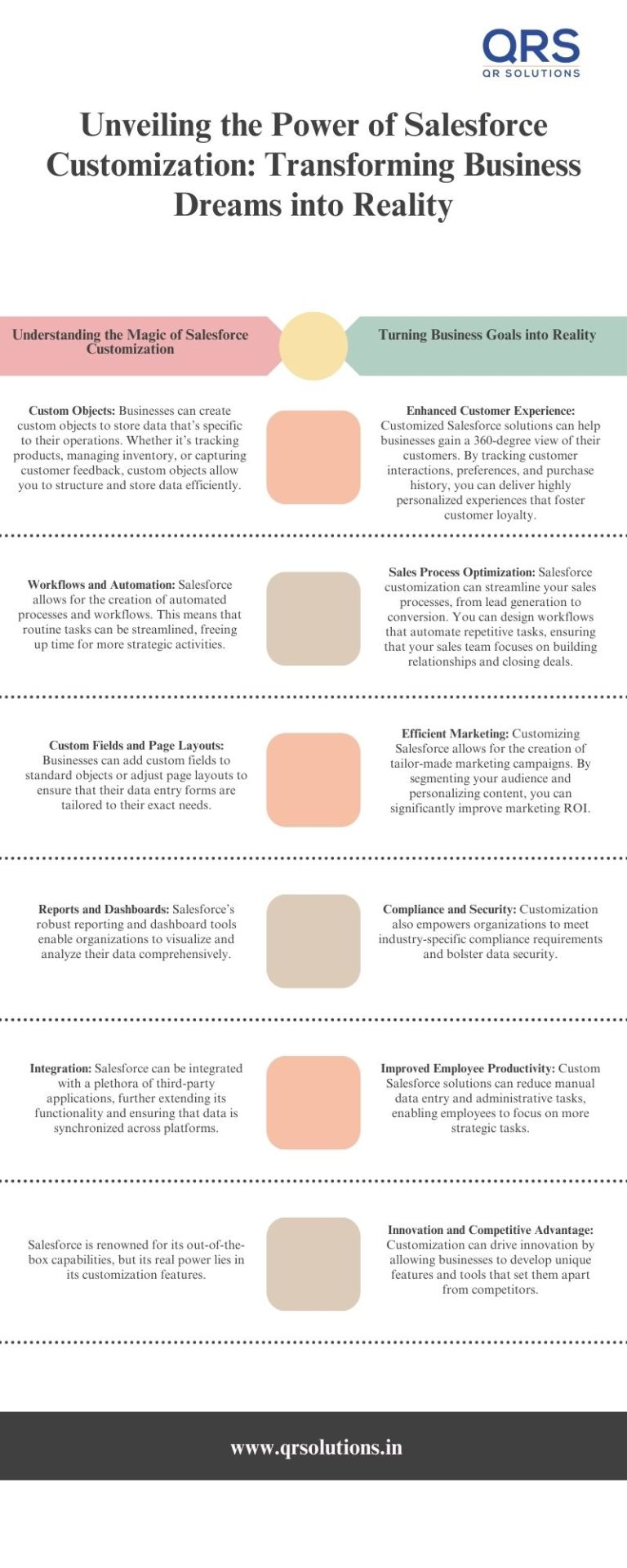
Salesforce customization is not merely an option, it's a necessity in today's rapidly changing business landscape.
To Know More Visit Us:
#Salesforce Customization#salesforce customization services#custom settings in salesforce#custom metadata in salesforce#CRM Customization#Custom Development#Customer Relationship Management#Custom App Development#App Customization#Customer Support#Salesforce Consultants#CRM Optimization
0 notes
Text
Let's Talk About Security Culture: Why Keeping Secrets is Cool and Sexy
It's a natural impulse -- if you love crime -- to want to talk about how great it is. And if you hate America, it's only natural to want to share your dreams for its future with the rest of tumblr dot com. It can feel brave and transgressive. And there is a drive to share your soul with the world at the heart of social media. Surely I should be posting the most concrete implications of my politics, right? This is the poster's curse.
Security Culture refers to a set of "best practices" developed over the past several decades, largely (in a US context) coming out of radical environmental groups as they faced intense state repression, infiltration and entrapment. If you're not familiar, there's some fascinating crimethinc write ups to give you a window into that world:
Much of it boils down to: don't talk about crimes, past or forthcoming with people who don't need to know about them, and be mindful of the possibility of surveillance and infiltration. And, we can support each other as a community in minimizing risks, with an eye towards enabling bold action rather than getting bogged down in fears and anxieties. The guidelines that make sense for AG-based trouble-makers are different from the guidelines that make sense for posters, but plenty of common principles apply. To speak briefly to our position here as posters:
First, it bears saying that long term anonymity is nearly impossible to maintain. Unless you've never accessed Tumblr without a vpn, and avoided connections with other ppl who can be associated with you/your location, and never shared pictures without scrubbing metadata, and a bunch of other 100% consistent steps, it's trivial for the state to know who you are.
Second, just because something isn't actively being prosecuted now doesn't mean it can't be prosecuted later. The priorities of the state change and a shift in power towards the right or a growth in radical action from the left can suddenly make it a priority to destroy anarchist networks or just find a few ppl to prosecute as examples (who probably weren't that plugged into larger networks before getting arrested). Advocating for specific anti-government crimes or declarations of intent to commit such crimes are likely prosecutable, and even if charges don't stick, they're an easy vector for legal harassment.
Third, it's worth thinking about heat as separate from prosecutability. There are modes of engagement that may not be directly criminalized but signal that you are someone worth watching. Some people choose to be public in ways that make heat unavoidable. But it's worth noting that heat isn't strictly individualized, that it persists over time but also is going to shrink over time.
It's easy on here, ime, to see yourself as a proud member of the crime fandom but not much of a content creator. And it's easy to feel like you've generated an amount of heat where you're locked into that role. But heat you generated 10 years ago is probably pretty well gone. Heat you generated 5 years ago has faded substantially. It's worth thinking about how the world might shift in the coming years and what doors you want to keep open.
The non-individualized nature of heat also means that leaning into the spiciest of anti-state positions will make it a bad idea for people who are acting out those positions end up tied to you. Loudly talking about how "more people should be doing [X/Y/Z]" unfortunately sets you up to remain distant from people who might be doing or thinking about doing such things.
Which brings me back to: keeping secrets is sexy. Not spelling everything out builds intrigue. You can lay out a theoretical position and leave working out the practical implications of that as an exercise for the reader. There's value in opacity. The poster's curse and the drive to confess are extremely convenient for the state, but we can resist them. We can hold dreams in our hearts that we refuse to offer up to the posting spectacle.
1K notes
·
View notes
Text
Alright kids, I've worked all evening on compiling this info, so to anyone who needs it:
PROTESTING SAFETY
------------------------------------------------
1. Preparation:
- Do not wear any accessories or anything identifiable. If you have tattoos or piercings, cover them up and hide them. Do NOT use makeup to cover them up either. In fact, don't wear makeup at all in ANY capacity, especially on the face, because it makes gases and sprays WORSE. Avoid jewerly entirely as it can be grabbed onto or traced back to you.
- Wear long sleeve shirts and pants and running shoes, CLOSED TOES, preferably all gray or black or all one singular (nonbright) color, neutrals. Avoid loose clothing and drawstrings. Wear head coverings, even more so if you have dyed hair. Nothing eye-catching, no slogans or logos, no customized or political clothing, nothing identifiable or unique that can be traced back to you. Wear head coverings that cover the entire head, including your ears, nose, and mouth.
- Make sure you can run in your outfit, just in case
- ***DO NOT WEAR CONTACTS, WEAR GLASSES INSTEAD***
I CANNOT stress that enough. If you wear glasses, make sure they're secure and cannot fall off easy.
- Helmets or elbow and knee patches are good for general safety but wear nothing that limits movement. Also, WEAR GOGGLES, but in a pinch firearm safety glasses of some kind can work. some sort of mask covering for your nose and mouth for, again, gases and sprays. A regular covid mask underneath a balaclava or bandana is better than nothing
- An extra note to medics: DO NOT wear anything that designates you publicly as a medic. A known medic is a targeted one. Only make it known you're a medic through word of mouth, **please**
- Write energency phone numbers on your body somewhere hidden, keep your ID and cash on you in a shoe or something but don't bring a wallet. If you have to bring a phone keep it shut down the entire time until you are far from the location the protest is happening, keep your biometrics and face ID off, turn off location services and if you take photo or video erase the metadata even if you don't plan on posting it.
- There are typically jail support and legal aid for protesters, find whats specific to your area and write their number. If you can get a lawyer, write their number down, too.
- PREFERABLY* go with a friend. Keep a designated meet up spot away from the protest to run to if things go south. If you are alone? get a buddy or make a friend at the protest so you both have someone to fall back on, and make it known to others that you are alone so they can watch out for you. If anything else, make sure at least 1 other person not at the protest knows where you are.
- Have backup meet-up spots in case of them being compromised, set up check-ins, too.
- KNOW YOUR RIGHTS BEFOREHAND, be prepared to exercise them
AGAIN on phones:
- have location data and airdrop turned off, AND in airplane mode because it can still ping towers with it off. Consider a faraday bag, if you can.
- turn off biometrics or face ID, cops can force you to open your phone. Again, preferably, keep it turned off
- burner phones are often registered with identifiable information so I don't recommend it, but if you can get it under someone else's information especially if they aren't going to be with yoy at the protest *with their consent
- if you are going to take video or photos for any reason, get CONSENT FIRST. Do NOT post anything in the moment. Only after the protest has concluded and once you've wiped the metadata. (And no, that screenshotting trick doesn't always work).
- use encrypted messaging, no socials, no texting, no phone calls. Verbal communication face to face is best
- while im on that topic: dont post anything beforehand either. Dont sign up to things on facebook, don't RSVP, and definitely don't post anywhere on social media that you're attending.
- Beforehand, look at maps of the area. Know your routes and exits.
------------------------------------------------
1.5. supplies:
- WATER WATER WATER, enough to stay hydrated AND to flush your eyes
- backpack or something secure AND crossbody to carry supplies in, one that doesnt limit movement and can't be pulled off easy
- umbrellas block projectiles, use them
- earplugs or eardefenders, *(do not get completely noise cancling because you still need to be aware of your surroundings)*
- some sort of snacks (not sugary, preferably): peanut butter crackers, slim jim, crackers, granola, trail mix, etc
- sunscreen, if not for you then someone else
- basic prepacked medkit supplies, bandages and gauze, if nothing else
- gloves (heat safe, oven mitts work too. They're for handling canisters thrown your way safely)
- BAIL MONEY, stored somewhere safe, probably in your shoes. Even if you intend on being peaceful, even if you don't do anything illegal or plan on it. They *will* still try to arrest you anyways.
- a change of clothes for afterward, both so you have clean, uncontaminated clothes, and so you're less likely to be identified after
- Whistle (noisemaker and you won't lose your voice as easily. Also, it's good for if you've been injured or need to call out for help)
- Sharpie to write on yourself if needed, notepad can be used to record badge numbers in future court cases
- card with crucial medical information such as blood type, disabilities, allergies, or other needs stashed somewhere on the chance of a medical emergency or being hospitalized.
Medic specific supplies:
- everything above^
- Water
- saline solution (found at wallgreens or walmart in eye sections, didinfectant and can be used to clear tear gas)
*note: I wouldn't recommend baby shampoo because it often had fragrances which can hurt more or damage your eyes, and sometimes oils too which can make it worse)
- safety scissors
- butterfly bandages and bandaids
- alcohol wipes and q-tips
- neosporin
- *latex free* gloves
- guaze
- tampons and pads to pack wounds
- duct tape
- emergency blanket
- did I mention WATER
- Extras of anything you can spare for those who are less prepared
IF YOU ARE BRINGING ANY FLAGS
- i urge you to bring American flags. Anything else and the media coverage can be twisted as an 'Us vs. Mexico" or "Us vs. Trans people". American flags let them know undeniably that no matter how they try to twist the narrative: *this is happening to U.S. citizens*
------------------------------------------------
2: While you're there
- Keep an EYE ON YOUR SURROUNDINGS. Exercise spatial awareness, keep an eye on the crowd and out of the crowd. This is easier said than done if you dont have a buddy, so I really recommend finding someone to group with.
- I recommend staying on the outskirts if you can. Avoid dark and enclosed areas in exchange for open and well lit ones. Watch out for infiltrators there to insight violence and agitate crowds, or undercover cops.
- DO NOT PANIC OR RUN, DO NOT SCREAM. It takes one person to make an entire group panic, and that can lead to violence, stampedes, crowd crushes... stay calm and react accordingly.
- Panicking can be read as aggression too, so all the more reason to stay calm. Alongside with that: do NOT be innebriated. Do not do drugs, do not drink alcohol. Stay sober, stay aware.
- If you are recording: narrate loud and clealy, narrate the time and date, the location, the events before and during recording. Footage is evidence that can be used in court. Blur and obscure faces with multiple methods
- If things get violent or go south, distance yourself and find somewhere to regroup. Be prepared to protect yourself, have umbrellas ready in defense of being shot at. I cannot stress this enough but 'rubber' bullets (metal encased in rubber btw) can still maim and kill. The police often shoot directly at people without regard for safety. Be careful.
- If police begin to surround and barricade your group, you are being locked in a *kettle*. (Yes, even if it's illegal in your state) They may keep you there for an extended period of time or attempt to arrest everyone. The safest way out if you see it coming back the way you came. Do NOT talk to the cops under any circumstances.
- If nobody talks, everybody walks
- if you are arrested, be prepared to exercise your rights and speak clearly. Not speaking clearly gives them cause to ignore you or take your words differently than what they mean because they have to obey the word and not the spirit of the law.
- if you are detained: "I am exercising my right to remain silent, I will not speak without an attorney present."
- They can't make you say shit without one, so do not say shit without one, no matter what they say. (Eventually) they will be forced to comply.
if tear gas cannisters are thrown:
- please note that throwing them back is a felony, do so only at your own risk
- USE HEAT SAFE GLOVES TO HANDLE, or else you WILL get burned
- COVER AND SMOTHER is the way to go. Pot lids or garbage can lids are great. Pouring water on them helps a lot
- SALINE IS BETTER THAN MILK BUT MILK IS BETTER THAN NOTHING. Saline is much more sterile and effective. Antacid mixtures are a safe backup, water is fine and milk is a last resort option.
- do not rub your eyes, blink and let your tear ducts do the work to flush them out or you will spread it further and deeper
- do not use oils or lotions to decontaminate your skin, breathe slowly, do not scream
- when/if you can, rinse yourself down with water
------------------------------------------------
3: afterwards...
- decontaminate yourself. Take your clothes off, especially if you've been gassed, and leave them at the door of your home and head to the shower in a palstic bag or trash bag.
- Shower with COLD water. Hot water opens pores and worsens chemical absorption. Rinse eyes and face first, wash your hair THOROUGHLY
- unscented soaps, fragrance oils can worsen contamination
- wash your clothes entirely seperated from your laundry and don't forget to include the afformentioned gloves/oven mitts if also contaminated. Wash on cold water
- DOCUMENT YOUR INJURIES including date, time, severity, and other details. Pictures too. Do a full body survery to make sure nothing is missed.
- Back up all footage and data to somewhere encrypted, preserve the original metadata for court and legal use only, and wipe everything completly of metadata and CENSOR FACES to anything shared publicly. If you're device was handled by the police change your passcode
- while the memories are fresh document everything, a timeline of events, crowd control tactics used, badge numbers of the officers, anything and everything and share only with a legal observer.
- Make sure to calm down and decompress. Check in with others, and yourself too. Hydrate, eat a full meal, get some rest
------------------------------------------------
3.5: If you are..
Arrested:
- to reitterate: do NOT speak to cops. Do NOT speak without a lawyer. KNOW AND EXERCISE YOUR RIGHTS
- If you are under 18 do not speak without a legal guardian, even with a lawyer present, if you can
- if you are injured during your arrest, report it upon arrival to jail. If they refuse care, insist that they document the refusal and note name, date, and time
- if you are assaulted or mistreated in your time there you can report it to legal aid organizations
- REMEMBER: "I am invoking my right to remain silent and my right to an attorney." Repeat as many times as needed
- if you get a phone call, either your emergency contact written on yourself or a jail support hotline is your first priority
- Do not unlock any devices if you can help it
- Upon release, get copies of everything and DOCUMENT. I can't stress that enough
Hospitalized/EMS:
- be honest with them. They don't have to tell the cops shit, they just want to know everything they need to treat you accordingly. Don't lie to them and it'll make their jobs easier.
- Again: THEY ARE NOT THE COPS. BE HONEST WITH THEM.
- ask for your treatment and injuries to be documented, this will help on future court cases as evidence.
- designate a release contact and make sure to follow up on care for anything serious.
I think that officially covers everything I can think of but if anyone has something to add dm me and let me know. I will update this as I find more information, and will get to work on making a better formatted version to print out when I can. Spread this as much as possible and repost wherever.
Stay safe everyone.
#no kings#no kings protest#protest#protest safety#donald trump#fuck trump#elon musk#fuck elon#protesting#safety tips#us politics
177 notes
·
View notes
Text
It's like letterboxd, but for porn!
This your routine reminder that I made a site for posting about what porn you've been watching!
Check out what other people have posted already!
It has a searchable database of over eighty thousand porn scenes. All of them have thumbnails and most of them have trailers.
You can even use that search page to make your own hyper specific porn randomizers. This page (for example) will play a preview video from a different random manyvids anal scene every time you load it (go see how many reloads it takes before you get served a video of me).
If there's a scene missing then you can probably get it added just by pasting in a link. It can scrap scene metadata from 25 different sites. It even automatically checks a handful of those sites every morning for new releases.
There are rewards for posting too. You can unlock a handful of my old scenes totally for free.
If you're on desktop then you can even customize your profile page's css (I replaced mine's background with looping gifs from bible black lol) (I disabled custom css on mobile just because of how little screen real estate there is).
221 notes
·
View notes
Text
How to back up your tumblr blog with Tumblr-Utils FOR MAC USERS
I've seen a few guides floating around on how to use some more complex options for backing up your tumblr blog, but most are extremely PC focused. Here is a guide for fellow (unfortunate) mac users!
Note: I am not a tech savvy person at all. My brother walked me through this, and I'm just sharing what he told me. Unfortunately I won't be able to help much if you need trouble shooting or advice ;; sorry! This is also based off of this guide (link) by @/magz.
- - - - GUIDE - - - -
First, open terminal. You can command+space to search through your applications, and search for "terminal". It should look like this.

You should see something like this within the window:
[COMPUTER NAME]:~ [USER NAME]$ []
First, create a virtual environment for tumblr back up. This will limit any conflicts with other python programs. Type and enter this into terminal:
python3 -m venv .tumblr_backup
Then, Activate the virtual environment by entering this:
source .tumblr_backup/bin/activate
The next line should now show something like this:
(.tumblr_backup) [COMPUTER NAME]:~ [USER NAME]$ []
As a side note, you can exit this virtual environment by typing and entering "deactivate". You can re-enter it through the previous line we used to activate it to begin with.
Next, install the base package with this line:
python3 -m pip install tumblr-backup
The linked guide details various options for tumblr back up packages that you can install. Copied from the guide for convenience:
"tumblr-backup : default tumblr-backup[video] : adds option to download videos tumblr-backup[exif] : adds option to download EXIF information of fotos (photography metadata information) tumblr-backup[notes] : adds option to download notes of posts (huge) tumblr-backup[jq] : adds option to filter which posts to backup tumblr-backup[all] : adds all options (personally doesn't work for us at the moment of writing this)"
I chose the video option, but you can pick which you'd like. Download that specific package with this line. Note that unlike the previous lines Ive shown, the square brackets here are actually part of it and must be used:
python3 -m pip install tumblr-backup[OPTION]
Next, you need to create an app linked to your tumblr account to get an OAuth consumer key (aka API key). Go to this link: [https://www.tumblr.com/oauth/apps] and click the [+Register application] button. Here, you will have to input a bunch of info. What you put doesn't really matter. This is how the original guide filled it out, and I did pretty much the exact same thing:

(The github link for your convenience: https://github.com/Cebtenzzre/tumblr-utils)
For the next step, You'll take the OAuth consumer key (NOT the secret key) and set it as the API key in tumblr-utils to give it the ability to download your blog. Input this line. Note that in this case, the square brackets are NOT to be included- just copy and paste the key:
tumblr-backup --set-api-key [YOUR OAUTH CONSUMER KEY]
This will set you up to start your back up! Type this to see all the different customization options you can pick from for your backup:
tumblr-backup --help
To begin your back up, pick which options you want to choose from and select which of your blogs you want to back up. It should look like this:
tumblr-backup [OPTIONS] [BLOG NAME]
For example, I am currently backing up this blog and I wanted to save videos as well as reversing the post order in the monthly archives. This is what my command looked like:
tumblr-backup -r --save-video bare1ythere
And there you have it! Your backup will be saved into a file titled after your blog. You can search through finder for it from there. There is also an option to specify where you want to save your blog, but I'm not sure how it works. I hope this was useful!!
93 notes
·
View notes
Text
One of America’s most corporate-crime-friendly bankruptcy judges forced to recuse himself

Today (Oct 16) I'm in Minneapolis, keynoting the 26th ACM Conference On Computer-Supported Cooperative Work and Social Computing. Thursday (Oct 19), I'm in Charleston, WV to give the 41st annual McCreight Lecture in the Humanities. Friday (Oct 20), I'm at Charleston's Taylor Books from 12h-14h.

"I’ll believe corporations are people when Texas executes one." The now-famous quip from Robert Reich cuts to the bone of corporate personhood. Corporations are people with speech rights. They are heat-shields that absorb liability on behalf of their owners and managers.
But the membrane separating corporations from people is selectively permeable. A corporation is separate from its owners, who are not liable for its deeds – but it can also be "closely held," and so inseparable from those owners that their religious beliefs can excuse their companies from obeying laws they don't like:
https://clsbluesky.law.columbia.edu/2014/10/13/hobby-lobby-and-closely-held-corporations/
Corporations – not their owners – are liable for their misdeeds (that's the "limited liability" in "limited liablity corporation"). But owners of a murderous company can hold their victims' families hostage and secure bankruptcies for their companies that wipe out their owners' culpability – without any requirement for the owners to surrender their billions to the people they killed and maimed:
https://pluralistic.net/2023/08/11/justice-delayed/#justice-redeemed
Corporations are, in other words, a kind of Schroedinger's Cat for impunity: when it helps the ruling class, corporations are inseparable from their owners; when that would hinder the rich and powerful, corporations are wholly distinct entities. They exist in a state of convenient superposition that collapses only when a plutocrat opens the box and decides what is inside it. Heads they win, tails we lose.
Key to corporate impunity is the rigged bankruptcy system. "Debts that can't be paid, won't be paid," so every successful civilization has some system for discharging debt, or it risks collapse:
https://pluralistic.net/2022/10/09/bankruptcy-protects-fake-people-brutalizes-real-ones/
When you or I declare bankruptcy, we have to give up virtually everything and endure years (or a lifetime) of punitive retaliation based on our stained credit records, and even then, our student debts continue to haunt us, as do lawless scumbag debt-collectors:
https://pluralistic.net/2023/08/12/do-not-pay/#fair-debt-collection-practices-act
When a giant corporation declares bankruptcy, by contrast, it emerges shorn of its union pension obligations and liabilities owed to workers and customers it abused or killed, and continues merrily on its way, re-offending at will. Big companies have mastered the Texas Two-Step, whereby a company creates a subsidiary that inherits all its liabilities, but not its assets. The liability-burdened company is declared bankrupt, and the company's sins are shriven at the bang of a judge's gavel:
https://pluralistic.net/2023/02/01/j-and-j-jk/#risible-gambit
Three US judges oversee the majority of large corporate bankruptcies, and they are so reliable in their deference to this scheme that an entire industry of high-priced lawyers exists solely to game the system to ensure that their clients end up before one of these judges. When the Sacklers were seeking to abscond with their billions in opioid blood-money and stiff their victims' families, they set their sights on Judge Robert Drain in the Southern District of New York:
https://pluralistic.net/2021/05/23/a-bankrupt-process/#sacklers
To get in front of Drain, the Sacklers opened an office in White Plains, NY, then waited 192 days to file bankruptcy papers there (it takes six months to establish jurisdiction). Their papers including invisible metadata that identified the case as destined for Judge Drain's court, in a bid to trick the court's Case Management/Electronic Case Files system to assign the case to him.
The case was even pre-captioned "RDD" ("Robert D Drain"), to nudge clerks into getting their case into a friendly forum.
If the Sacklers hadn't opted for Judge Drain, they might have set their sights on the Houston courthouse presided over by Judge David Jones, the second of of the three most corporate-friendly large bankruptcy judges. Judge Jones is a Texas judge – as in "Texas Two-Step" – and he has a long history of allowing corporate murderers and thieves to escape with their fortunes intact and their victims penniless:
https://pluralistic.net/2021/08/07/hr-4193/#shoppers-choice
But David Jones's reign of error is now in limbo. It turns out that he was secretly romantically involved with Elizabeth Freeman, a leading Texas corporate bankruptcy lawyer who argues Texas Two-Step cases in front of her boyfriend, Judge David Jones.
Judge Jones doesn't deny that he and Freeman are romantically involved, but said that he didn't think this fact warranted disclosure – let alone recusal – because they aren't married and "he didn't benefit economically from her legal work." He said that he'd only have to disclose if the two owned communal property, but the deed for their house lists them as co-owners:
https://www.documentcloud.org/documents/24032507-general-warranty-deed
(Jones claims they don't live together – rather, he owns the house and pays the utility bills but lets Freeman live there.)
Even if they didn't own communal property, judges should not hear cases where one of the parties is represented by their long term romantic partner. I mean, that is a weird sentence to have to type, but I stand by it.
The case that led to the revelation and Jones's stepping away from his cases while the Fifth Circuit investigates is a ghastly – but typical – corporate murder trial. Corizon is a prison healthcare provider that killed prisoners with neglect, in the most cruel and awful ways imaginable. Their families sued, so Corizon budded off two new companies: YesCare got all the contracts and other assets, while Tehum Care Services got all the liabilities:
https://ca.finance.yahoo.com/news/prominent-bankruptcy-judge-david-jones-033801325.html
Then, Tehum paid Freeman to tell her boyfriend, Judge Jones, to let it declare bankruptcy, leaving $173m for YesCare and allocating $37m for the victims suing Tehum. Corizon owes more than $1.2b, "including tens of millions of dollars in unpaid invoices and hundreds of malpractice suits filed by prisoners and their families who have alleged negligent care":
https://www.kccllc.net/tehum/document/2390086230522000000000041
Under the deal, if Corizon murdered your family member, you would get $5,000 in compensation. Corizon gets to continue operating, using that $173m to prolong its yearslong murder spree.
The revelation that Jones and Freeman are lovers has derailed this deal. Jones is under investigation and has recused himself from his cases. The US Trustee – who represents creditors in bankruptcy cases – has intervened to block the deal, calling Tehum "a barren estate, one that was stripped of all of its valuable assets as a result of the combination and divisional mergers that occurred prior to the bankruptcy filing."
This is the third high-profile sleazy corporate bankruptcy that had victory snatched from the jaws of defeat this year: there was Johnson and Johnson's attempt to escape from liability from tricking women into powder their vulvas with asbestos (no, really), the Sacklers' attempt to abscond with billions after kicking off the opioid epidemic that's killed 800,000+ Americans and counting, and now this one.
This one might be the most consequential, though – it has the potential to eliminate one third of the major crime-enabling bankruptcy judges serving today.
One down.
Two to go.

If you'd like an essay-formatted version of this post to read or share, here's a link to it on pluralistic.net, my surveillance-free, ad-free, tracker-free blog:
https://pluralistic.net/2023/10/16/texas-two-step/#david-jones

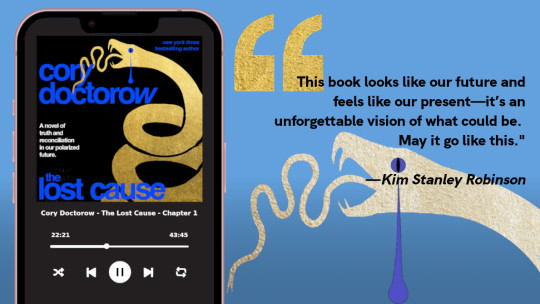
My next novel is The Lost Cause, a hopeful novel of the climate emergency. Amazon won't sell the audiobook, so I made my own and I'm pre-selling it on Kickstarter!
#pluralistic#texas two-step#bankruptcy#houston#texas#mess with texas#corruption#judge david jones#fifth circuit#southern district of texas#elizabeth freeman#yescare#corizon#prisons#private prisons#prison profiteers#Michael Van Deelen#Office of the US Trustee#sacklers#bankruptcy shopping#johnson and johnson#impunity
259 notes
·
View notes
Text
Saving Fic Epubs and Metadata Using Calibre
I FINALLY spent time learning how to set up Calibre with the FanFicFare plugin in order to easily keep track of fics that I've read. What's really awesome about it, though, is it does way more than just "keep track":
It saves epubs for future downloading (in case the fic is pulled from AO3)
It automatically "scrapes" metadata (title, tags, warnings, etc.) from the fic and includes it in Calibre's built-in spreadsheet
Allows you to create custom categories for things like notes and personal ratings, as well as categories for metadata not scraped by default (word count, for example).
Every bit of information scraped is SEARCHABLE and SORTABLE! Tags, authors, published date, etc.
However, the instructions for how to do all this are not clear-cut and are scattered on different sites and forums. So I've created a little guide based on what worked for me!
Here are my categories (if you know me the fic shown is not a surprise). I couldn't fit them into one long horizontal screenshot so I split them into two.


Most of these are default categories, but some (Thoughts, Words, Summary, Ratings, and Notes) are not. I've excluded default categories I didn't need, and created custom ones for the information I wanted to include.
Tutorial below the cut!
Download and install Calibre.
Once the program is open, click Preferences > Get plugins to enhance calibre Search for and install the FanFicFare and EpubMerge plugins (EpubMerge works in tandem with FFF and allows for downloading an entire fic series into one file).
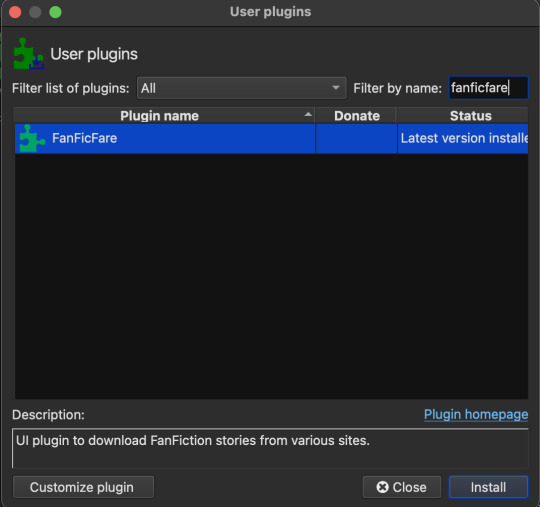

_________________
Custom Columns
Preferences > Preferences > Add your own columns The custom column screen is shown below. Anything unchecked is a category I didn't want to include in my list. Anything with a column icon next to it means its a custom column I created. To create a new column, click +Add custom column.
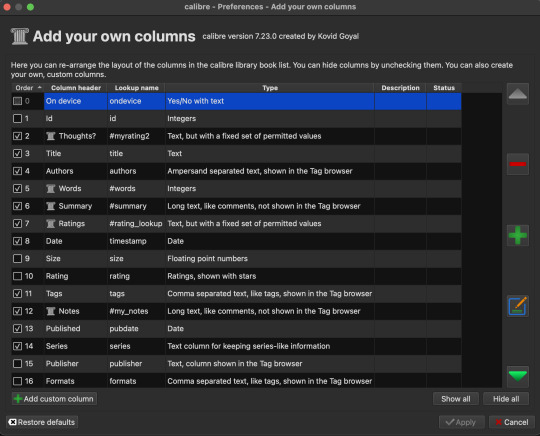
The settings I made for each of my custom categories are shown below. Take note of the "column type" for each category. You can make any kind of columns you'd like!
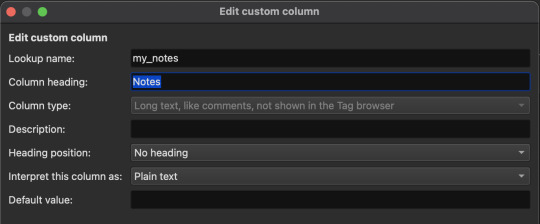
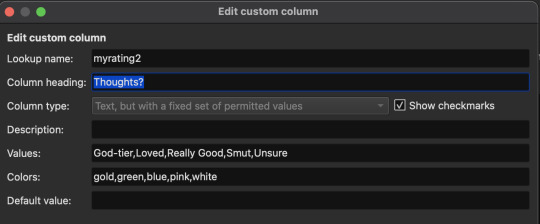
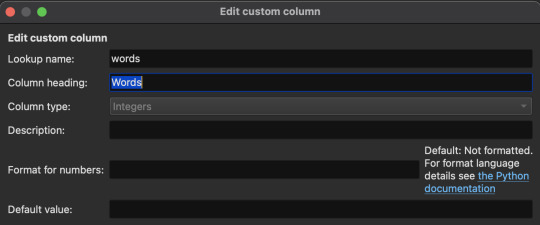
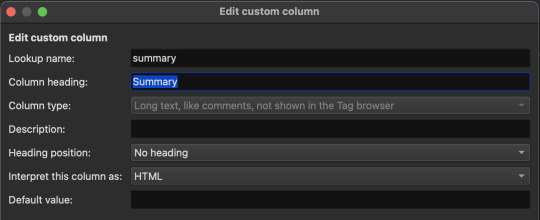
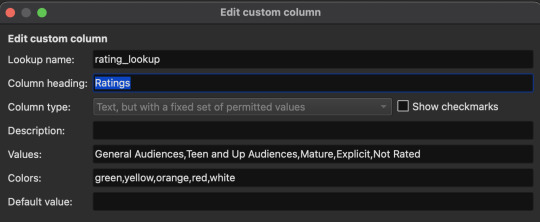
Once you've made your custom categories make sure to click Apply on the "Add your own columns" screen. Now we need to configure the FanFicFare plugin to assign data to some of the custom categories. Click the down arrow next to the FanFicFare plugin icon on the main Calibre screen, then click Configure FanFicFare. On the next screen click the Custom Columns tab.
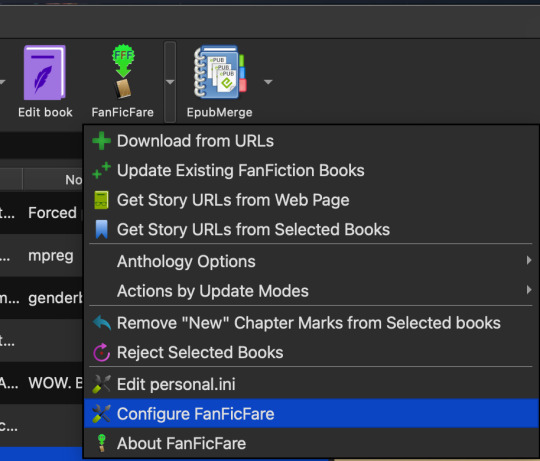
You will see a list of your custom columns with drop-down menus next to each. For columns you want the plugin to automatically fill, click the drop-down and select the matching data from AO3. There are many options to choose from, including pairing, language, warnings, etc. Note that I left the Notes and Thoughts columns blank. This is because I will input that information manually for each fic.
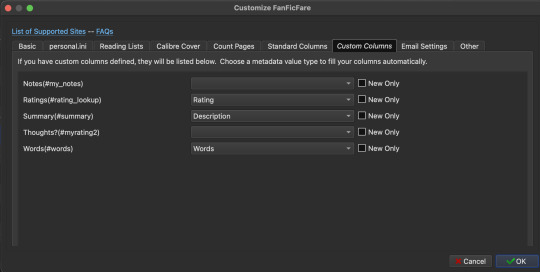
_________________
Downloading Individual Fics
Arrow next to FanFicFare > Download from URLs Paste in entire-work fic URLs into the black box. I personally found it tedious to copy/paste each link, so instead I found a Firefox extention called Copy All Tab URLs that does exactly what it says on the tin: copies all URLs from any open tabs. Much easier. Click OK. Then, WAIT. It takes a minute to fetch the data. If a fic is restricted, the plugin may show a pop-up asking you to log into AO3 so that it can access the fic.

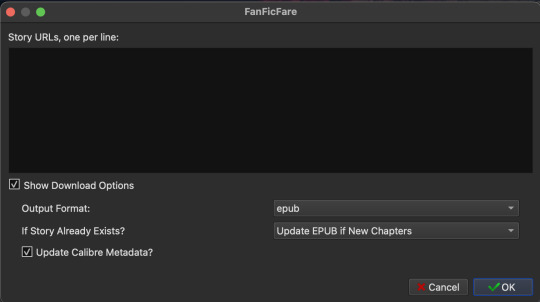
You're good to go when you see the following pop-up in the bottom-right corner. Click Yes.

_________________
Downloading An Entire Series
FanFicFare combined with EpubMerge allows you to download an entire series into one epub file!
Arrow next to FanFicFare > Get Story URLs from Web Page
Paste in the link to the SERIES page.
Click For Anthology Epub to download everything in that series into a single epub.
The next screen lists all the links in that series. Nothing to do here but click OK.
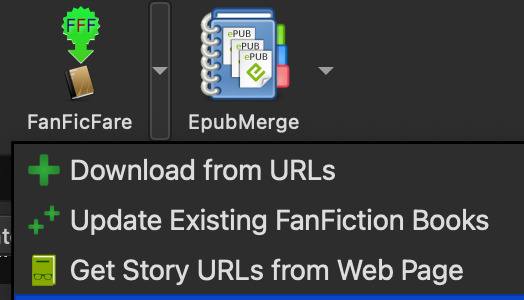
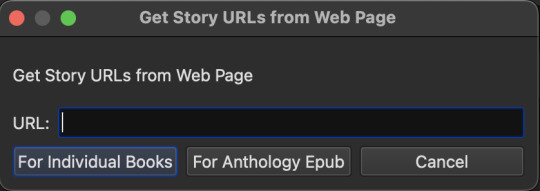
34 notes
·
View notes
Note
Hello! Would you ever consider bringing back different post types, especially audio? I appreciate that audio posts now display the artist, song title, and album name, but unfortunately newer audio posts don’t play in Tumblr-based music players like egoisticalgoat.de or robinpx.github.io/boombox because they’re read as text posts. Thank you for reading!
Answer: Hey there, @stepintomusic!
Sadly, the answer here is no. We’ve been moving away from legacy post types and towards the Neue Post Format—a format that allows multiple types of media in the same post—for many years. The new features available in NPF basically guarantee that we won’t ever switch back to the legacy format.
(If you’re interested in peeking behind the scenes here, there are a few posts about NPF over at @engineering.)
Now, to get into the meat of the issue. While it would be amazing if we could support every third-party tool forever, the reality is that we can’t. We’re a surprisingly small team to begin with, and even if we weren’t, that support would come at a cost.
To start, there’s the development tax. Now, would it have been cool to ensure all third-party tools (and all custom themes) worked 100% perfectly with posts stored as NPF before releasing NPF to the public? Yeah, it would have been… for third-party tools and custom themes. For us, it would have meant delaying NPF (and all the features it brings with it) for months, possibly years. Imagine a 2023 where Tumblr still doesn’t have polls: that’s the alternate future we’re talking about here.
And then, there’s our maintenance tax. The engine that powers Tumblr themes is already incredibly complicated—complicated to the point that we’re already finding it difficult to maintain and add things like, as you mentioned, NPF audio metadata. If, every time we found some third-party tool that doesn’t play nice with the latest changes, we tried to make an affordance for it… the engine would just become even more complex. And it would do so quickly, and complex to the point of being impossible to keep up with as a maintainer.
There’s a great article here by a former Mozilla developer about the pitfalls of prioritizing a third-party ecosystem over your own software. Did you know that Firefox was essentially a single-threaded application until 2018? This meant it would still visually lock up when saving files to disk, or collecting crash data. Chrome launched in 2008 and was multiprocess from the start. But it took Firefox ten years to catch up because supporting all existing third-party add-ons was seen as necessary. (Spoiler alert: in the end, they had to drop support for those add-ons anyway.)
My own recommendation around third-party software like this is: get in contact with its developer! If something in their software isn’t working, there’s nobody more qualified to update it. (Or, if they’ve abandoned the project but had made it open-source, maybe someone else could step up to maintain it. Maybe you! You never know until you try.)
I talked about the maintenance tax from the first-party side, but let’s talk about it from the third-party side, too. As a theme author and add-on developer myself, I have long accepted that the cost of maintaining these things can never be zero. When your software interacts with an online service, and that online service is being actively maintained, your software also needs to be maintained.
I hope all this has been enlightening! Thanks for your question, and please, have a great day.
—April
207 notes
·
View notes
Text
Obsidian Tutorial - Making & Using Templates
God I love templates. Consistent layouts of notes AND less typing? I’m a simple man with simple pleasures. There are a lot of things you can do with templates, and with certain plugins they can get quite complicated, but the basics are pretty straightforward.

[ID - a purple decorative divider]
Head to the settings menu and find core plugins. Toggle on the Templates plugin.

[ID - a screenshot of the Obsidian settings menu, in the Core Plugins section. The ‘templates’ plugin is highlighted and toggled on.]
Under the core plugins section in the settings menu, head to ‘Templates’ to set up a few basics
The most important one is your template folder location - this is the place you’ll save all your templates. I have one in my Meta folder just called ‘Templates’ - I recommend making a similar, clearly named folder so it’s easy to find
The date and time format options are slightly more complicated additions: there are certain formats you can use in basic templates to automatically fill in date and time, and this is where you set how you want that format to look. Don’t worry about it too much - you’re safe to leave it as the default if you want.
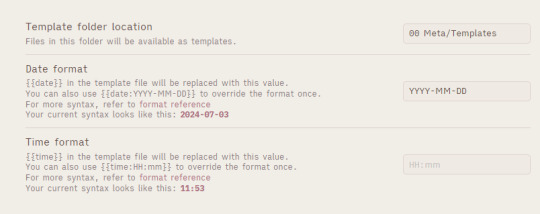
[ID - a screenshot of the Template plugin settings in Obsidian. At the top, the template folder location is filled out as ‘00 Meta/Templates’.]
Once you have your folder location set up, you can start making templates!
A simple example might be a character profile: create a new note, and lay out the text the way you’d like it to look, but without any specific details in.
Make sure the note is in your template folder
You can now use that note as a template! You can insert it into a new note either by using the command palette and the ‘insert template’ command, or you can assign a hotkey (I use Ctrl+T) and use that
Congratulations, you have now saved yourself approximately a million years of repetitive typing, and the stress of remembering how you want to lay out character profiles, journals, blog posts, and any number of other things
Bonus - free templates!
I have a handful of templates I’ve made, and you can grab them for free here:
character profile
country
fictional organisation
fic
scene yaml
RPG NPC template (requires dataview & metadata menu plugins for full automation, but you can delete those parts and use it manually as well)
RPG location template
Monthly planner (requires dataview)
Note: some of these make use of the ITS infobox custom CSS - i wrote a rough guide to installing it here

[ID - a purple decorative divider]
check out my obsidian tag for more posts
check out the tutorials tag for other obsidian tutorials
obsidian resources masterpost
download obsidian
got questions? tutorial suggestions? want to say hi?
#obsidian md#obsidian.md#obsidian tutorials#writing tools#templates my beloved#and then you can get really crazy and start using quickadd to auto-make things#and if you’re smarter than me you can use templater and do wild things#or so i’m told#i cannot wrap my head around templater so godspeed to those of you who want to use it
34 notes
·
View notes
Text
i wanna talk more about using VLC to listen to music 👉🏻👈🏻 i wanna move away from spotify so bad and irs felt like a good step towards doing that. rn i kinda just use it for ambient stuff though (mostly dungeon synth)
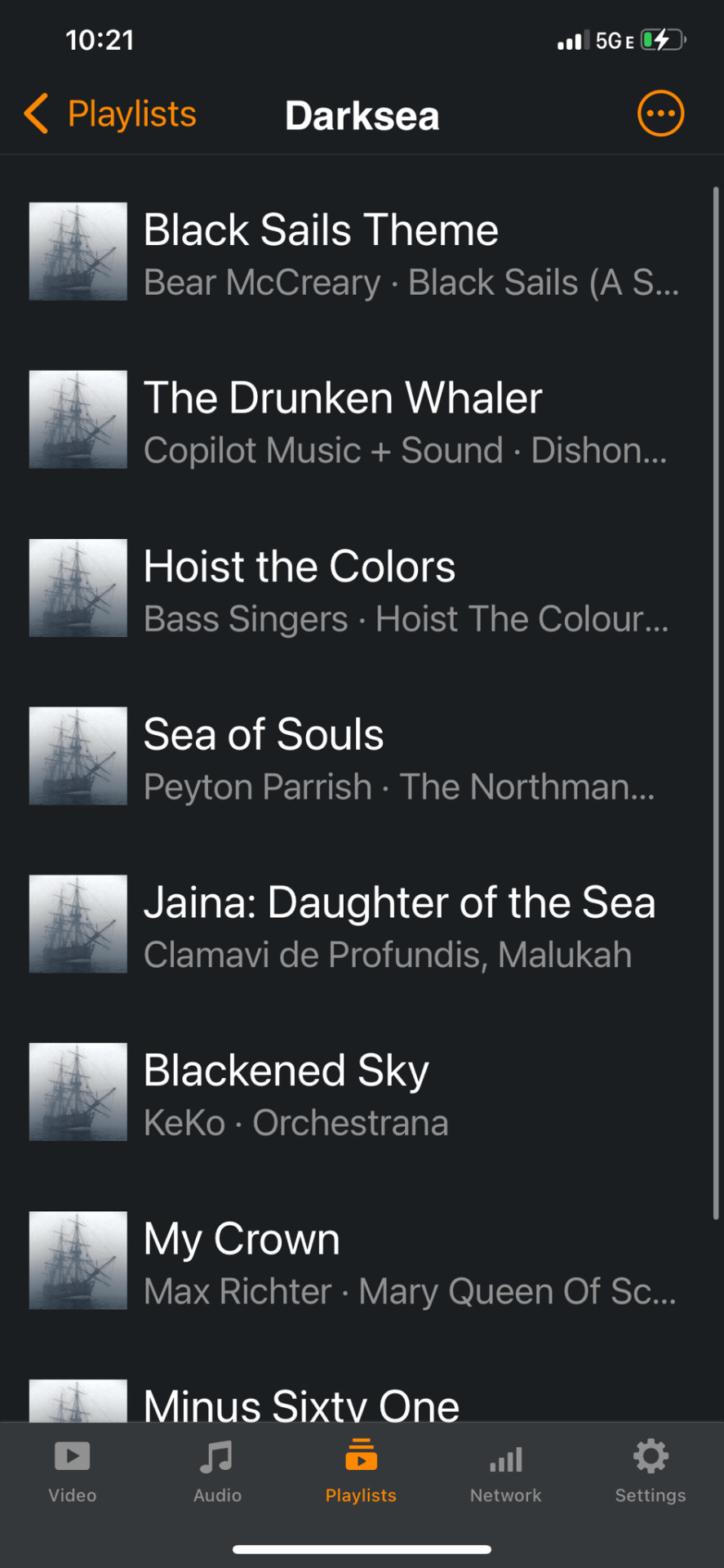
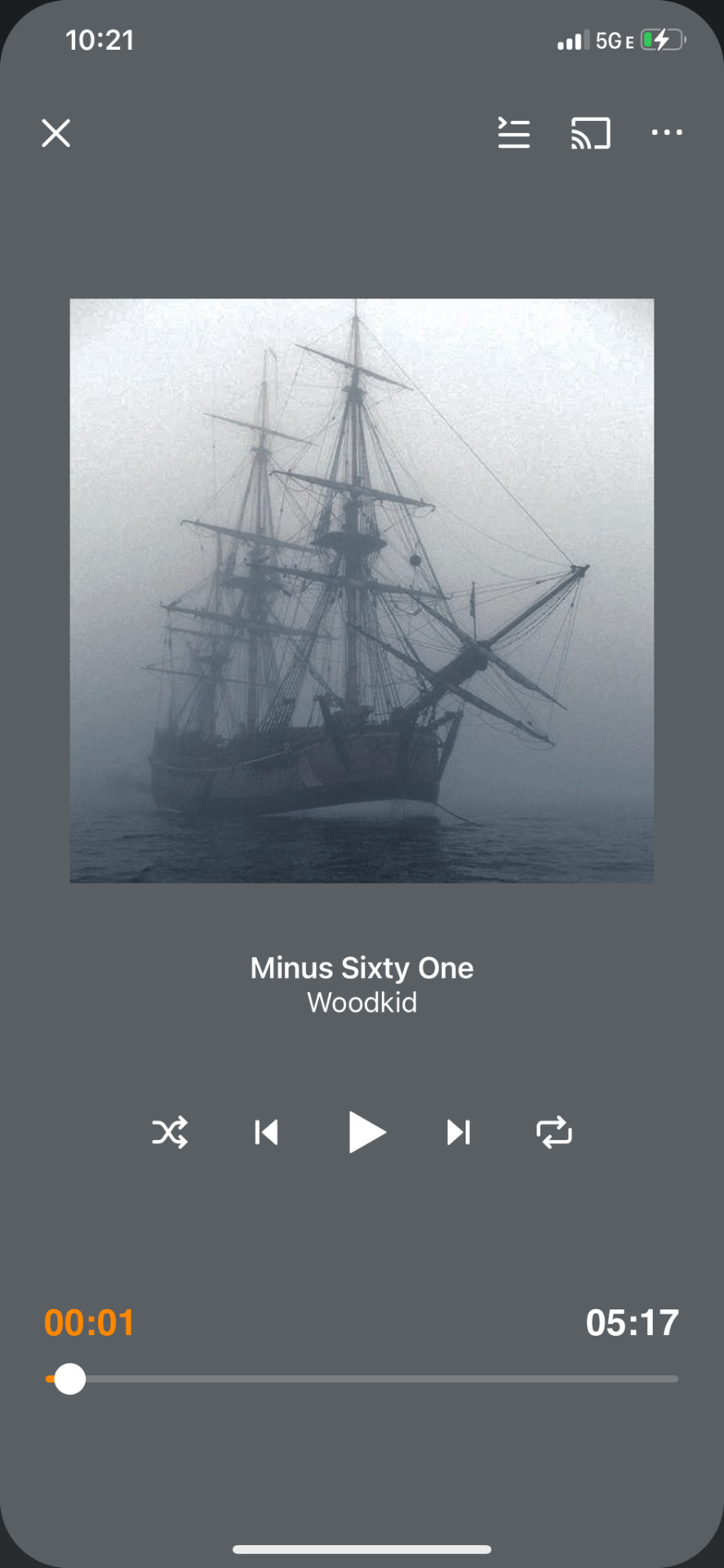
(this is from a playlist i put together for. the second. world i’m worldbuilding) my fave part is adding custom album covers for the songs w/ mp3tag
it’s like. surprisingly easy to do this??

you can upload your mp3s from your desktop and download them via wifi onto your phone. that’s literally it they’re now in there and will be sorted according to their metadata (albums can act a little weird sometimes though but that’s the only issue i’ve had)

this is my collection so far (this truly is 90% dungeon synth) but i do still use spotify for most music since i have literallt thousands of songs saved there. right now my goal is to listen to more niche stuff here and put hyper specific playlists on here
also not at all related to VLC but DIM’s compendiums go crazy i fucking love them
7 notes
·
View notes
Text

Salesforce customization is not merely an option, it's a necessity in today's rapidly changing business landscape.
To Know More Visit Us:
#Salesforce Customization#salesforce customization services#custom settings in salesforce#custom metadata in salesforce#CRM Customization#Custom Development#Customer Relationship Management#Custom App Development#App Customization#Customer Support#Salesforce Consultants#CRM Optimization
0 notes